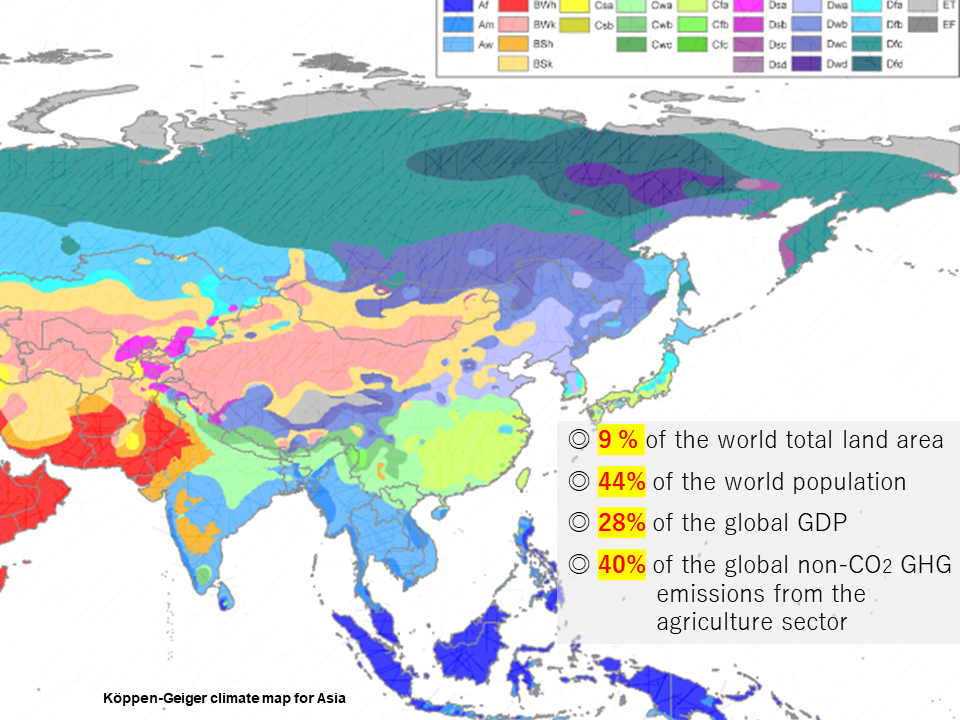Pick Up
1058. World Population Day 2024: Demographic and Economic Share of the Asian Monsoon Region in the Global Context

1058. World Population Day 2024: Demographic and Economic Share of the Asian Monsoon Region in the Global Context
July 11 is World Population Day. World Population Day was proposed by the United Nations Population Fund in 1989 to raise awareness of the world's population problem, and was officially designated as an international day by the United Nations General Assembly in 1990. This day was chosen because the world's population exceeded 5 billion on July 11, 1987.
JIRCAS launched the Green Asia project in 2022 with the aim of promoting the application of Japanese agricultural, forestry and fisheries technologies in the Asian monsoon region, drawing on its many years of experience in international joint research in the field of agriculture, forestry, and fisheries, and providing information on its website. This time, we introduce the demographic and economic share of the Asian monsoon region from the Green Asia Report Series "Driving sustainable food systems transformation in the Asia-Monsoon region with science, technology, and innovation: background and key issues for 'Green Asia' project".
The Region’s Demographic and Economic Shares in the Global Context
If the total area of 23 countries and economies is considered, 3.99 billion or 52% of the global population live on 15% of the world’s total land area and generate 33% of the global GDP (Table 3). For China and India*, administrative units falling under the Asia Monsoon climates corresponded to 33% and 69% of the total land area, respectively. In turn, in both countries, proportionally more people and economic activities are concentrated in the ‘monsoon’ climates, making their population and GDP shares 75% and 78% in China and 77% and 73% in India, respectively.
* For China and India, we examined the data at administrative (province or state) levels and considered that those administrative units falling under the Köppen climate types of Af, Am, Aw, Cw, Cfa, or Cfb would be included in the Asia-Monsoon region.
Under this arbitral delineation of the Asia-Monsoon region for this study, an estimated 3.34 billion people or 44% of the world’s population as of 2018 live in areas corresponding to 9% of the world’s total land area, while accounting for 28% of the global GDP. In other words, the Asia-Monsoon region, occupying merely one-tenth of the world’s land area, has a significant global demographic and economic presence. The population density of the Asia-Monsoon region stands at 292 persons per square kilometer (3.34 billion people living in an area of 11,445, 000 km2), almost five-fold that of the world average (59 persons per square kilometer, derived from 7.63 billion people divided by 130,000,000 km2).
The region’s economy is destined to grow, and food insecurity remains a persistent problem. According to recent UN estimates, while between 702 and 828 (768 median) million people were affected by hunger, over half of them were found in Asia (at 425 million or 9.1% of the regional population) and Africa (278 million or 20.2%); 10.5% of the Asian population suffered from severe food insecurity.
According to the UN's World Population Prospects, under the medium variant scenario, over the course of the 21st century, the global share of the Asia-Monsoon region population (the populations of China and India were estimated at 75% and 77% of that of the countries, respectively) will gradually decrease from 44% in 2020 to 40% in 2050 and to 31% in 2100 (Figure 3), due to the growing share of that of Africa in the coming decades. Under the UN’s medium variant scenario, the absolute regional population will grow by 420 million to 3.88 billion by 2050.
Therefore, the region still needs to boost food production to meet the growing demand for food to ensure food security and poverty alleviation, and shift diets in line with projected economic development and urbanization.
World Population Prospects 2022
https://population.un.org/wpp/
Reference
Driving sustainable food systems transformation in the Asia-Monsoon region with science, technology, and innovation: background and key issues for "Green Asia" project
https://www.jircas.go.jp/ja/publication/gars-e/1
Contributors: IIYAMA Miyuki, Information Program; KANAMORI Norihito, Southeast Asia Liaison Office
